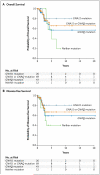Mutations in GNA11 in uveal melanoma
- PMID: 21083380
- PMCID: PMC3107972
- DOI: 10.1056/NEJMoa1000584
Mutations in GNA11 in uveal melanoma
Abstract
Background: Uveal melanoma is the most common intraocular cancer. There are no effective therapies for metastatic disease. Mutations in GNAQ, the gene encoding an alpha subunit of heterotrimeric G proteins, are found in 40% of uveal melanomas.
Methods: We sequenced exon 5 of GNAQ and GNA11, a paralogue of GNAQ, in 713 melanocytic neoplasms of different types (186 uveal melanomas, 139 blue nevi, 106 other nevi, and 282 other melanomas). We sequenced exon 4 of GNAQ and GNA11 in 453 of these samples and in all coding exons of GNAQ and GNA11 in 97 uveal melanomas and 45 blue nevi.
Results: We found somatic mutations in exon 5 (affecting Q209) and in exon 4 (affecting R183) in both GNA11 and GNAQ, in a mutually exclusive pattern. Mutations affecting Q209 in GNA11 were present in 7% of blue nevi, 32% of primary uveal melanomas, and 57% of uveal melanoma metastases. In contrast, we observed Q209 mutations in GNAQ in 55% of blue nevi, 45% of uveal melanomas, and 22% of uveal melanoma metastases. Mutations affecting R183 in either GNAQ or GNA11 were less prevalent (2% of blue nevi and 6% of uveal melanomas) than the Q209 mutations. Mutations in GNA11 induced spontaneously metastasizing tumors in a mouse model and activated the mitogen-activated protein kinase pathway.
Conclusions: Of the uveal melanomas we analyzed, 83% had somatic mutations in GNAQ or GNA11. Constitutive activation of the pathway involving these two genes appears to be a major contributor to the development of uveal melanoma. (Funded by the National Institutes of Health and others.).
Figures



Comment in
-
Taking the guesswork out of uveal melanoma.N Engl J Med. 2010 Dec 2;363(23):2256-7. doi: 10.1056/NEJMe1010681. Epub 2010 Nov 17. N Engl J Med. 2010. PMID: 21083377 No abstract available.
Similar articles
-
Activating cysteinyl leukotriene receptor 2 (CYSLTR2) mutations in blue nevi.Mod Pathol. 2017 Mar;30(3):350-356. doi: 10.1038/modpathol.2016.201. Epub 2016 Dec 9. Mod Pathol. 2017. PMID: 27934878 Free PMC article.
-
Oncogenic GNAQ and GNA11 mutations in uveal melanoma in Chinese.PLoS One. 2014 Oct 3;9(10):e109699. doi: 10.1371/journal.pone.0109699. eCollection 2014. PLoS One. 2014. PMID: 25280020 Free PMC article.
-
Patient survival in uveal melanoma is not affected by oncogenic mutations in GNAQ and GNA11.Br J Cancer. 2013 Jul 23;109(2):493-6. doi: 10.1038/bjc.2013.299. Epub 2013 Jun 18. Br J Cancer. 2013. PMID: 23778528 Free PMC article.
-
GNAQ and GNA11 mutations in uveal melanoma.Melanoma Res. 2014 Dec;24(6):525-34. doi: 10.1097/CMR.0000000000000121. Melanoma Res. 2014. PMID: 25304237 Review.
-
Research in practice: Therapeutic targeting of oncogenic GNAQ mutations in uveal melanoma.J Dtsch Dermatol Ges. 2020 Nov;18(11):1245-1248. doi: 10.1111/ddg.14288. Epub 2020 Sep 21. J Dtsch Dermatol Ges. 2020. PMID: 32954611 Review.
Cited by
-
From melanocytes to melanomas.Nat Rev Cancer. 2016 Jun;16(6):345-58. doi: 10.1038/nrc.2016.37. Epub 2016 Apr 29. Nat Rev Cancer. 2016. PMID: 27125352 Review.
-
A distinct subset of atypical Spitz tumors is characterized by BRAF mutation and loss of BAP1 expression.Am J Surg Pathol. 2012 Jun;36(6):818-30. doi: 10.1097/PAS.0b013e3182498be5. Am J Surg Pathol. 2012. PMID: 22367297 Free PMC article.
-
Oncogenic Tyrosine Phosphatases: Novel Therapeutic Targets for Melanoma Treatment.Cancers (Basel). 2020 Sep 29;12(10):2799. doi: 10.3390/cancers12102799. Cancers (Basel). 2020. PMID: 33003469 Free PMC article. Review.
-
Exome sequencing identifies recurrent somatic mutations in EIF1AX and SF3B1 in uveal melanoma with disomy 3.Nat Genet. 2013 Aug;45(8):933-6. doi: 10.1038/ng.2674. Epub 2013 Jun 23. Nat Genet. 2013. PMID: 23793026 Free PMC article.
-
Low mutational burden of eight genes involved in the MAPK/ERK, PI3K/AKT, and GNAQ/11 pathways in female genital tract primary melanomas.Biomed Res Int. 2015;2015:303791. doi: 10.1155/2015/303791. Epub 2015 Jan 28. Biomed Res Int. 2015. PMID: 25695059 Free PMC article.
References
-
- Singh AD, Bergman L, Seregard S. Uveal melanoma: epidemiologic aspects. Ophthalmol Clin North Am. 2005;18:75–84. - PubMed
-
- Saldanha G, Purnell D, Fletcher A, Potter L, Gillies A, Pringle JH. High BRAF mutation frequency does not characterize all melanocytic tumor types. Int J Cancer. 2004;111:705–10. - PubMed
-
- Davies H, Bignell GR, Cox C, et al. Mutations of the BRAF gene in human cancer. Nature. 2002;417:949–54. - PubMed
-
- Pollock PM, Harper UL, Hansen KS, et al. High frequency of BRAF mutations in nevi. Nat Genet. 2003;33:19–20. - PubMed
Publication types
MeSH terms
Substances
Grants and funding
LinkOut - more resources
Full Text Sources
Other Literature Sources
Medical
Molecular Biology Databases
